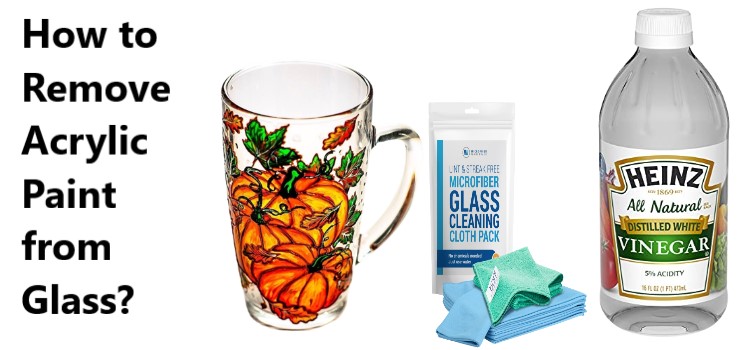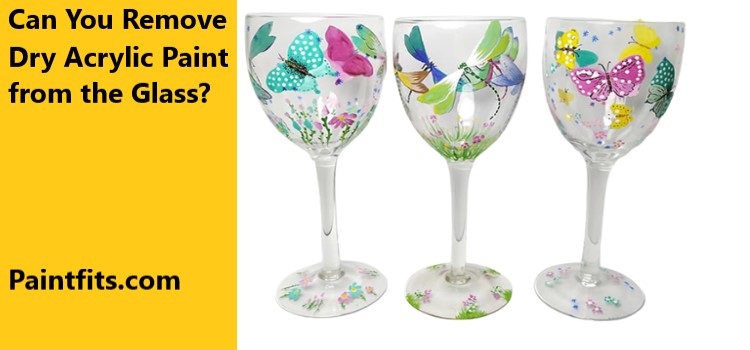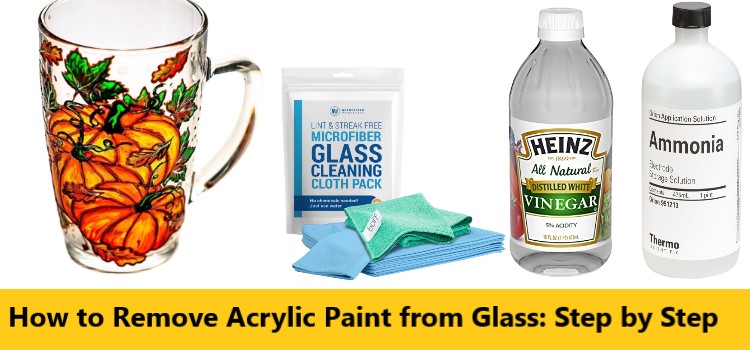Artists love acrylic paints because of their versatility. And you can use these on almost all surfaces. Because of their thick consistency, the colors appear exquisitely bright and beautiful.

Glass is one of the best mediums for acrylic paint art. But what if the paint spills into some unwanted areas, and you need to make corrections? Is it possible?
You can remove acrylic paint from the glass with regular household items. Just wiping the acrylic paint with a clean wet cloth can remove most of the paint. You can also use a vinegar solution for a better result.
So, it’s needless to reach for the panic button if you drip some paint here and there while working. Just go through this piece to pick up some tricks to remedy the situation in an instant. If you act soon enough, removing acrylic paint from glass-made objects will not be difficult.
Contents
Can You Remove Acrylic Paint From Glass?
Yes, it is pretty easy to remove acrylic paint from glass because glass is a non-porous material. The non-porous nature of glass prevents the glass from absorbing liquids, so the paint will only stay on the surface.

Therefore in many cases, you can get rid of unwanted paint with a simple wipe. However, sometimes you would need to make a bit more elaborate approach.
Can You Remove Dry Acrylic Paint from the Glass?
As we mentioned earlier, acrylic paint removal can be pretty straightforward if the paint is still fresh. A wet towel wipe might prove to be enough. But what if the paint dries off? Can you wash it off as easily as before it dried? Unfortunately, the answer is no. You will face a far trickier challenge when the paint dries off.
Acrylic emulsion binds pigment in water-based acrylic paint. Why emulsion instead of a solution? The acrylic resin is not water-soluble. So, only emulsion can create a water-acrylic mixture. When the water in acrylic paint evaporates, the polymer molecules link up and form a film of acrylic paint that sticks together.

Once the film is dry, it no longer dissolves in water. To get dried acrylic paint off a porous or non-porous surface, you will need a cleaner that can dissolve the acrylic resin. You will need something that can at least make it stick less. So, it is possible to clean off dried acrylic paint from the glass if you use an appropriate cleaner like ammonia solution or rubbing alcohol.
How to Remove Acrylic Paint from Glass: 2 Methods

Method 1: The Simplest Trick
Step 1: Take a piece of dry cloth and soak it in water.
Step 2: Gently wipe it across the freshly spilled paint. The sooner you do this after the spill, the more effective it is likely to be.
Step 3: Wipe a few more times to get rid of the paint completely. Allow the moisture to go away completely before you try to paint again. Once you are convinced the glass has dried off, it is ready for a fresh coat of paint.
Method 2: Try Some Vinegar
Step 1: Take three tablespoons of white vinegar and mix it with equal water in a bowl. Then, pour the mixture into a pot and boil it. Don’t forget to put on your gloves while working. Otherwise, you will burn the skin of your hands.
Step 2: Set a towel down next to the surface you are going to clean to make it easier to clean up. You can also put the pot of water and vinegar here.
Step 3: Since you would not want burn scars on your hands, you should wait until the vinegar solution cools down sufficiently. Take a washcloth and dip it in vinegar. Slowly scrub the glass with the vinegar-soaked cloth to get rid of the paint.
Next Read: Some easy ways to remove paint from aluminum boats
How to Remove Dried Acrylic Paint from Glass?
The methods we have described above are ineffective in removing dried paint from glass. When the paint dries, it becomes more permanent on the surface.

So, you would require a more robust cleaning agent to pull out the acrylic paint pigment from the glass. We will highlight five substances that can prove very useful in this scenario.
Ammonia Solution
Acrylic paint can be easily removed from non-porous surfaces like metal, glass, and plastic with regular household ammonia. This is because ammonia can raise the pH level in emulsions and make them more stable. Sudsy ammonia is perfect for the job since it has detergent in it. Detergent pulls out resilient acrylic particles and makes it easier for you to rinse them off.
How to Get Acrylic Paint Off Glass With Ammonia
Step 1: Add two tablespoons of ammonia to a half cup of water and ¼ teaspoon of liquid soap. Avoid the soap if you are using sudsy ammonia since it already has soap mixed with it.
Step 2: Take the mixture in a spray bottle and shake it well so that the ingredients get properly mixed. You now have a potent glass cleaner in your hands!
Step 3: Spray the mixture on the acrylic, wait for some time and then wipe the paint off with a soft fabric. Repeat this a couple of times to make sure you got all unnecessary paint out.
Step 4: Wash the glass in clean water afterward to make sure there are no remnants of the ammonia mixture.
CAUTION:
1. Don’t feel tempted to add bleach to the mix. It will damage the glass and create toxic fumes.
2. Don’t clean the glass under direct sunlight. It will make the solution dry off quickly and leave streaks on the glass.
Rubbing Alcohol
Rubbing alcohol, which chemistry purists call isopropyl alcohol, can be used to remove dried acrylic from non-porous surfaces and clothing with a little bit of work. What we like about rubbing alcohol is that it’s dirt cheap, and you can find it in your local convenience store. You would want to use the 99% concentration. However, you might have to order it online.
How to Get Acrylic Paint Out Of Glass With Rubbing Alcohol
Step 1: Prepare a 1:3 dilution of rubbing alcohol. That means preparing a solution that has three parts water and one part rubbing alcohol. A numerical example should make this more simplified. If you take 5ml of rubbing alcohol, add three times the water to it. So, you should add 15ml of water to make a 1:3 dilution of rubbing alcohol.
Step 2: You can choose to take the solution in a spray bottle or in a bowl. Apply generous amounts of the mixture to the dried off acrylic paint.
Step 3: Wipe the glass with a piece of fabric. The paint should start to come off.
Step 4: After the paint is completely gone, wash the glass in clean water to remove the remaining traces of the mixture.
Denatured Alcohol
Denatured alcohol serves as a more powerful glass cleaner than isopropyl alcohol. It is a blend of methyl and ethyl alcohol and exhibits excellent efficiency in dissolving acrylic particles.
So, you can consider using denatured alcohol instead of rubbing alcohol if the stains prove more resilient. It’s perfectly safe to use on glasses if you use the right concentration.
How to Clean Dried Off Acrylic Paint With Denatured Alcohol
Step 1: Prepare a 1:1 dilution of denatured alcohol. In more simplified terms, take a certain amount of denatured alcohol and add an equal amount of water. If you take 10ml of denatured alcohol, make sure to mix it with 10ml of water.
Step 2: Take the denatured alcohol mixture in a spray bottle and spray it over the acrylic paint.
Step 3: Wipe the paint off with a washcloth afterward.
Step 4: Once the paint is removed, rinse the glass with clean water. Otherwise, the remnant mixture in the glass could lead to future stains. It would also hamper the quality of future acrylic paint work.
Acetone
Acetone is not suitable for use on plastic surfaces as its too abrasive for them. But, it’s still a good choice for glass. If you need a heavy-duty acrylic paint remover, acetone could be just the thing for you! You can buy cans of acetone in any hardware store. It’s non-toxic, but it’s highly flammable. So, don’t smoke while using acetone.
How to Use Acetone to Remove Dried Off Acrylic Paint
Step 1: Pour a small amount of acetone onto the acrylic paint. You can use an old toothbrush to apply acetone if you want. Don’t dilute it because you would need the full might of acetone to clean the glass.
Step 2: Scrub with a non-abrasive scrubber after applying the acetone. The paint should begin to come off.
Step 3: Wash the glass well after removing the paint. Acetone will harm the glass if it stays on longer.
Final Words
Cleaning unwanted patches of acrylic paint from glasses is not much of a big deal in most cases. The key is to get to it as soon as you can. That said, it would not be the end of the world if you could react before the paint dries off. There are many cleaners available that can eradicate the paint from your glasswork.
